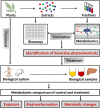Emerging applications of metabolomics in studying chemopreventive phytochemicals
- PMID: 23794098
- PMCID: PMC3787217
- DOI: 10.1208/s12248-013-9503-5
Emerging applications of metabolomics in studying chemopreventive phytochemicals
Abstract
Phytochemicals from diet and herbal medicines are under intensive investigation for their potential use as chemopreventive agents to block and suppress carcinogenesis. Chemical diversity of phytochemicals, together with complex metabolic interactions between phytochemicals and biological system, can overwhelm the capacity of traditional analytical platforms, and thus pose major challenges in studying chemopreventive phytochemicals. Recent progresses in metabolomics have transformed it to become a robust systems biology tool, suitable for examining both chemical and biochemical events that contribute to the cancer prevention activities of plant preparations or their bioactive components. This review aims to discuss the technical platform of metabolomics and its existing and potential applications in chemoprevention research, including identifying bioactive phytochemicals in plant extracts, monitoring phytochemical exposure in humans, elucidating biotransformation pathways of phytochemicals, and characterizing the effects of phytochemicals on endogenous metabolism and cancer metabolism.
Figures



Similar articles
-
LC-MS-Based Metabolomic Investigation of Chemopreventive Phytochemical-Elicited Metabolic Events.Methods Mol Biol. 2016;1379:77-88. doi: 10.1007/978-1-4939-3191-0_7. Methods Mol Biol. 2016. PMID: 26608291
-
Regulation of MicroRNAs by Phytochemicals: A Promising Strategy for Cancer Chemoprevention.Curr Cancer Drug Targets. 2018;18(7):640-651. doi: 10.2174/1568009617666170623124710. Curr Cancer Drug Targets. 2018. PMID: 28669335 Review.
-
Reassessing the role of phytochemicals in cancer chemoprevention.Biochem Pharmacol. 2024 Oct;228:116165. doi: 10.1016/j.bcp.2024.116165. Epub 2024 Mar 26. Biochem Pharmacol. 2024. PMID: 38527559 Review.
-
Ins and outs of dietary phytochemicals in cancer chemoprevention.Biochem Pharmacol. 2007 Aug 15;74(4):533-44. doi: 10.1016/j.bcp.2007.02.014. Epub 2007 Feb 28. Biochem Pharmacol. 2007. PMID: 17382300 Review.
-
Recent advances in cancer chemoprevention with phytochemicals.J Food Drug Anal. 2020 Jan;28(1):14-37. doi: 10.1016/j.jfda.2019.11.001. Epub 2019 Nov 25. J Food Drug Anal. 2020. PMID: 31883602 Review.
Cited by
-
Measures Matter-Determining the True Nutri-Physiological Value of Feed Ingredients for Swine.Animals (Basel). 2021 Apr 27;11(5):1259. doi: 10.3390/ani11051259. Animals (Basel). 2021. PMID: 33925594 Free PMC article. Review.
-
Reconceptualization of Hormetic Responses in the Frame of Redox Toxicology.Int J Mol Sci. 2021 Dec 21;23(1):49. doi: 10.3390/ijms23010049. Int J Mol Sci. 2021. PMID: 35008472 Free PMC article. Review.
-
Genistein and Glyceollin Effects on ABCC2 (MRP2) and ABCG2 (BCRP) in Caco-2 Cells.Int J Environ Res Public Health. 2015 Dec 22;13(1):ijerph13010017. doi: 10.3390/ijerph13010017. Int J Environ Res Public Health. 2015. PMID: 26703673 Free PMC article.
-
Exploring Four Atraphaxis Species: Traditional Medicinal Uses, Phytochemistry, and Pharmacological Activities.Molecules. 2024 Feb 19;29(4):910. doi: 10.3390/molecules29040910. Molecules. 2024. PMID: 38398660 Free PMC article. Review.
-
Plant Metabolomics: The Future of Anticancer Drug Discovery.Pharmaceuticals (Basel). 2024 Sep 30;17(10):1307. doi: 10.3390/ph17101307. Pharmaceuticals (Basel). 2024. PMID: 39458949 Free PMC article. Review.
References
Publication types
MeSH terms
Substances
LinkOut - more resources
Full Text Sources
Other Literature Sources

